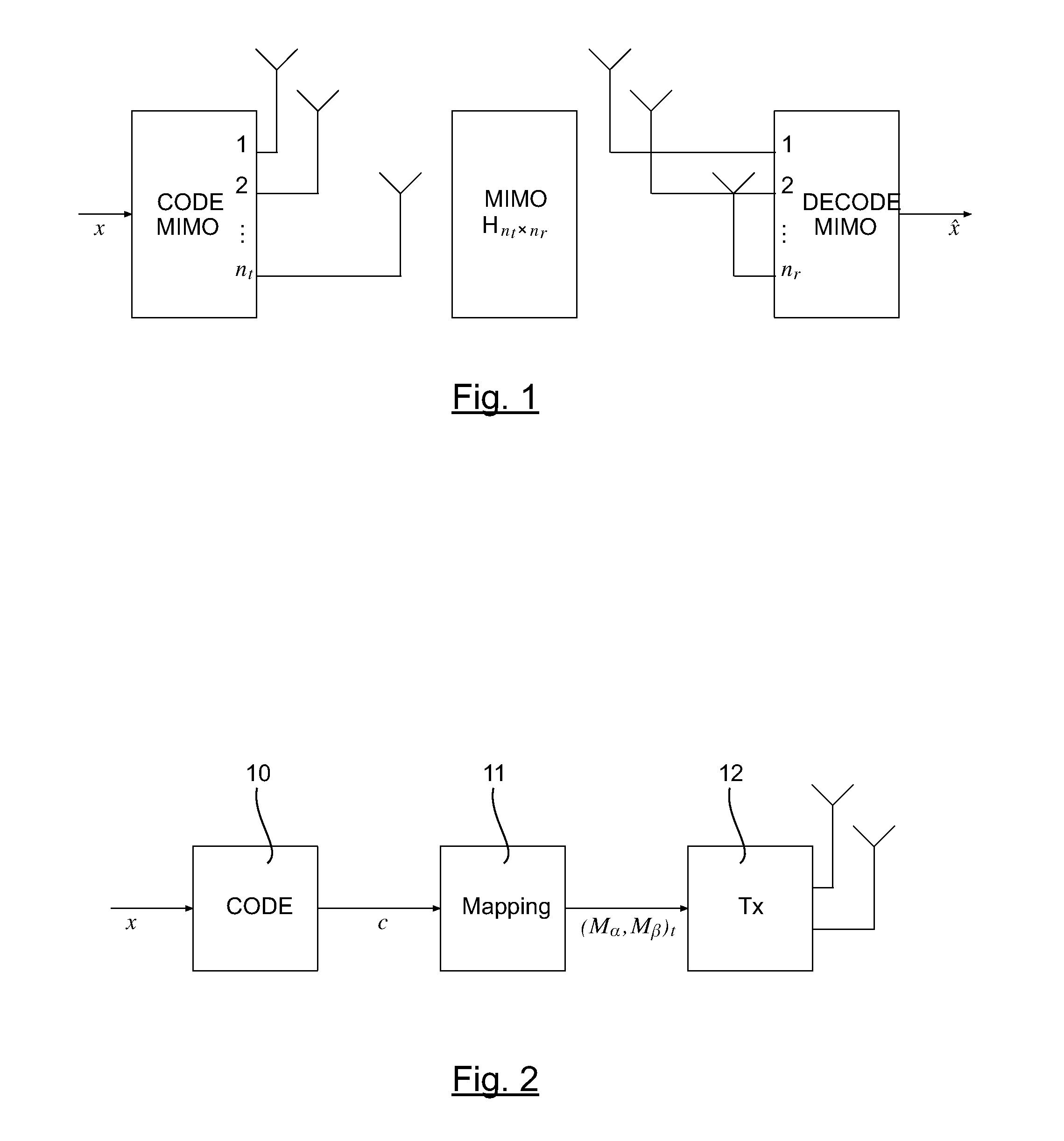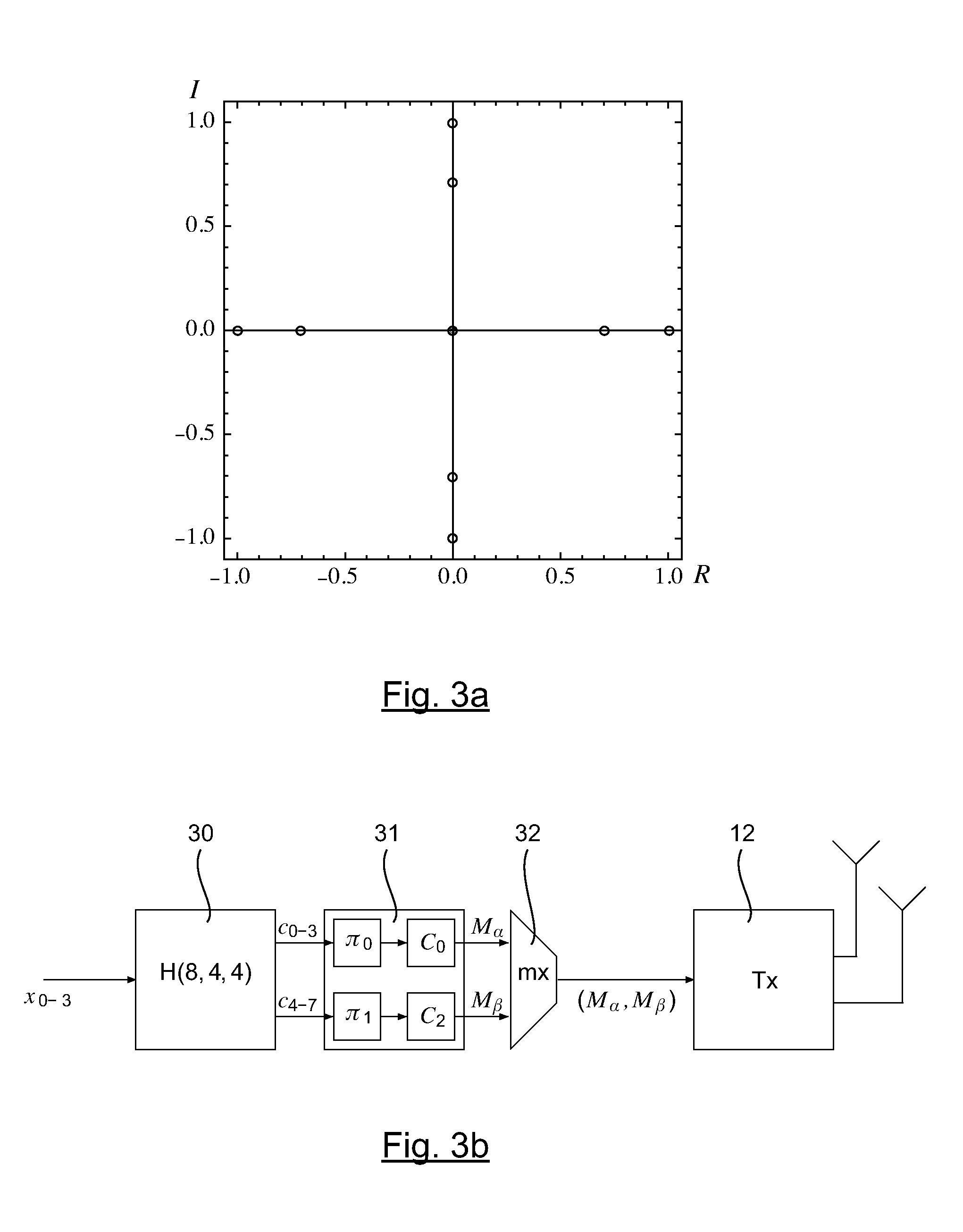Method and device for transmission and reception in a multi-input and multi-output channel distributing a code word between several mapping matrices, and corresponding computer program
a multi-input and multi-output technology, applied in the field of digital communication, can solve the problems of 3 db loss of performance as compared with transmission, non-coherent mimo differential techniques, and lack of encoding gain, so as to reduce the need for channel knowledge and improve the effect of building efficiency
- Summary
- Abstract
- Description
- Claims
- Application Information
AI Technical Summary
Benefits of technology
Problems solved by technology
Method used
Image
Examples
second embodiment
[0138]3. Description of a Second Embodiment Referring to FIGS. 4, 5a and 5b, a description is now given of a second example of an embodiment of the invention implementing a 2×2 matrix modulation and a convolutive error-correcting code deduced from the (8,4,4) Hamming block code in unfolding and repeating its 4-state tail-biting trellis to infinity, for a MIMO system comprising two sending antennas and two receiving antennas.
[0139]This convolutive code known as a Hamming code is built from the trellis known as the “tail-biting” trellis or circular trellis of the Hamming block code described here above.
[0140]This small convolutive code, the trellis of which is very simple, as shown in FIG. 5a for a 4-state trellis with three sections, enables the principle of this embodiment to then be extended to all the codes capable of including one or more trellises in their description such as for example the turbo-codes described especially in the document by Claude Berrou and al., “Codes and tu...
third embodiment
[0161]4. Description of a Third Embodiment
[0162]Referring to FIGS. 6a to 6c, a description is now given of a third example of an embodiment of the invention implementing a 2×2 matrix modulation and a Golay convolutive error-correcting code for a MIMO system comprising two sending antennas and two receiving antennas.
[0163]According to this embodiment, the mapping matrices are no longer selected in the Weyl group but built so as to comply with the properties required by an embodiment of the invention, namely invertibility and compliance with the criterion of uniqueness of the cancellation of the syndrome.
[0164]Thus, as illustrated in FIG. 6a from a sliding window of four bits x03=(x0, x1, x2, x3) of information to be transmitted, the step 60 of convolutive encoding produces eight bits c07=(c0, C1, c2, . . . c7).
[0165]The code used is for example the convolutive Golay code described in E. Cadic, J. C. Carlach, G. Olocco, A. Otmani and J. P. Tillich, “Low Complexity Tail-Biting Trellise...
fourth embodiment
[0183]5. Description of a Fourth Embodiment
[0184]As already indicated here above, in a fourth embodiment, the invention enables the transmission of 16 encoded bits c0-15.
[0185]To this end, an embodiment of the invention uses a modulation close to the MAQ16 modulation where the first level is mapped towards (±1±as for the previous embodiment and the second level towards (±1±) / 2.
[0186]According to this embodiment of the invention, the eight first bits are mapped so as to obtain a first invertible matrix A=M(c0-7) and the last eight bits c8-15 are mapped so as to obtain a second invertible matrix B=M (c8-15) .
[0187]The overall mapping matrix obtained corresponds to the sum (A+B / 2) which is an invertible matrix with complex coefficients, the constellation of which is shown in FIG. 7a.
[0188]The other steps when sending and then receiving are identical to the third embodiment described here above.
PUM
 Login to View More
Login to View More Abstract
Description
Claims
Application Information
 Login to View More
Login to View More - R&D
- Intellectual Property
- Life Sciences
- Materials
- Tech Scout
- Unparalleled Data Quality
- Higher Quality Content
- 60% Fewer Hallucinations
Browse by: Latest US Patents, China's latest patents, Technical Efficacy Thesaurus, Application Domain, Technology Topic, Popular Technical Reports.
© 2025 PatSnap. All rights reserved.Legal|Privacy policy|Modern Slavery Act Transparency Statement|Sitemap|About US| Contact US: help@patsnap.com



